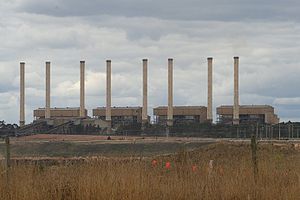| Hazelwood Power Station | |
|---|---|
 | |
 Location of the Hazelwood Power Station in Victoria, Australia. | |
| Country | Australia |
| Location | Latrobe Valley, Victoria |
| Coordinates | 38°16′22″S 146°23′30″E / 38.27278°S 146.39167°E |
| Status | Decommissioned |
| Commission date | 1964 |
| Decommission date | 2017 |
| Owners |
|
| Thermal power station | |
| Primary fuel | Lignite |
| Turbine technology | Steam turbine |
| Power generation | |
| Units operational | 6 x CA Parsons & Company 2 aei units |
| Nameplate capacity | 1,600 MW (2,100,000 hp) |
| Annual net output | 12,000 GWh (43,000 TJ) |
| External links | |
| Website | www |
| Commons | Related media on Commons |
The Hazelwood Power Station is a decommissioned brown coal-fuelled thermal power station located in the Latrobe Valley of Victoria, Australia. Built between 1964 and 1971, the 1,600-megawatt-capacity power station was made up of eight 200MW units, and supplied up to 25% of Victoria's base load electricity and more than 5% of Australia's total electricity demand.[1][unreliable source?] It was a 'subcritical' pulverized coal-fired boiler.[2] The station was listed as the least carbon efficient power station in the OECD in a 2005 report by WWF Australia, making it one of the most polluting power stations in the world.[3] At 1.56 tonnes of CO2 for each megawatt hour of electricity, it was 50% more polluting than the average black coal power station in New South Wales or Queensland. Hazelwood emitted 14% of Victoria's annual greenhouse gas emissions and 3% of Australia's greenhouse gas emissions.
International Power plc purchased Hazelwood Power Station and the adjoining mine from the Victorian Government in 1996 with an expected 40-year life. In 2005, the Bracks government approved an environmental effects statement (EES) that allowed Hazelwood to relocate a road and a section of the Morwell River to allow access to an additional 43 million tonnes of coal in addition to that allowed under the mining licence boundaries set at the time of privatisation. This was estimated to provide sufficient coal for the plant to operate to at least 2030 (prior to decommissioning plans). The EES also capped its expected total greenhouse output at 445 million tonnes of carbon dioxide over its life, after which Hazelwood may have been made to cease operation.
Hazelwood was jointly owned by Engie with a 72% share and Mitsui & Co with a 28% share.[4] In 2014, Hazelwood employed 495 staff directly and on average 300 contractors. On 3 November 2016, Engie announced that the entire Hazelwood plant would be closed at the end of March 2017 giving five months notice of the closure.[5][6] The power station closed in March 2017.[7] When the power station closed, wholesale prices in Victoria were up 85% on 2016, according to the Australian Energy Regulator, and for the first time in almost a decade, the state relied on energy from interstate to meet its needs.[8]
A 150 MW one-hour grid battery opened in June 2023.[9]
- ^ "Hazelwood Power Station, Australia". power-technology.com.
- ^ "Fossil Energy in Australia". Aneroid Energy.
- ^ "Hazelwood tops international list of dirty power stations". WWF. 12 July 2005.
- ^ "Hazelwood Power Station & Mine". GDF Suez. Archived from the original on 8 May 2014. Retrieved 29 March 2014.
- ^ "Hazelwood power station in Australia to close at the end of March 2017". Engie. 3 November 2016. Retrieved 3 November 2016.
- ^ "'Heartbreaking' Hazelwood closure to leave hundreds jobless". ABC News. 3 November 2016. Retrieved 3 November 2016.
- ^ What we'll do to keep the lights on post Hazelwood: grid operator
- ^ Government confident power bills won’t soar after Yallourn shuts
- ^ Parkinson, Giles (14 June 2023). ""Day for history books:" Hazelwood becomes first coal plant to transition to big battery". RenewEconomy.